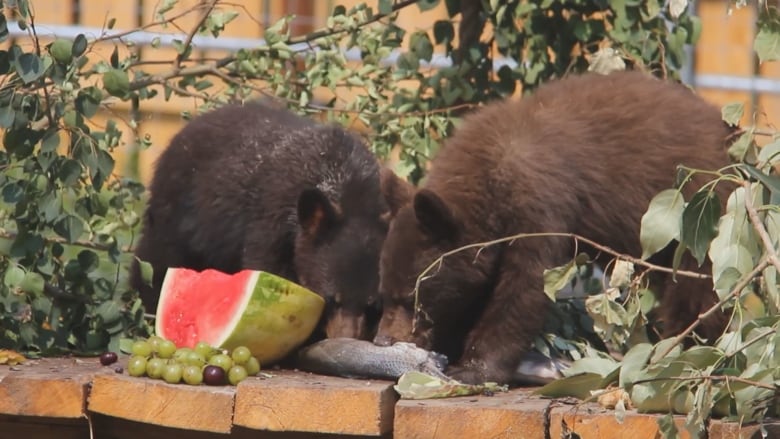New bear enclosure open at Alberta Institute for Wildlife Conservation
Its called the Bear Den and it's already home to 2 orphaned cubs
The Alberta Institute for Wildlife Conservationhas opened a new enclosure aimed at caring for and rehabilitating bears rescued in the province.
The agency completed construction of the new space, which it calls the Bear Den, in early July, and it's already home to two orphaned bear cubs.
Scottie Potter, communications co-ordinator at AIWC, says bear cubs are brought to the animal hospital when they are abandoned or their mother has been killed. She says the new space was created with efficiency and safety in mind to care for bears and to limit human interaction with the animals.
Cubs often have injuries or trauma when they'rebrought to the animal hospital, which is about 20 kilometres northwest of Calgaryin Rocky View County.
"Our first bear cub patient she's got brown fur she came in with some severe neurological issues," Potter said. "She was found at a roadside. Whether or not she was hit by a car, we weren't sure. She had some head trauma and she was having seizures.
"She recovered really, really well. She's a very feisty young bear."

Potter says the second bear cub patient was brought in after being observed in the wild for 24 hours straight with no parent in sight. Shewas treated for digestive issues.
Potter notes the young femalegets along quite well with the other cub and theyspend a lot of time "just cuddling in the den together."
Since the bears were moved to the new enclosure, space has been freed up for other animals, such as red foxes.
"That was super important for us. And so having this bear space really made our summer much smoother and easier for caring for tons of different mammals," Potter said. "It wasn't just bears, not just foxes. We've got weasels, we've got tons of skunks. And so it's been a very mammal summer, and this bear enclosure really helped."
Potter likens the Bear Den to something similar to a fortress. The enclosure can house up to eight bear cubs and has to be able to withstand the strength of the animals. Although bear cubs are significantly smaller than their adult counterparts, a bear cub is a force to be reckoned with.
"They're very strong, they're incredible climbers. The climbing, in particular, is a huge reason why our fences are so extensive, and we do have some electrified wires around the perimeter as well," she said.

AIWC has a 100 per cent success rate in rehabilitating black bears and reintroducing them into the wild, an achievement Potter attributes to precautions taken by staff to ensure the bears have minimal interaction with humans.
"We have a privacy fence, and that is to limit the amount of visual stimuli to the bears from the outside, because bears can habituate to human presence quite easily," she explained.
Cass Lacusta, rehabilitation manager for the agency, says the two cubs treat each other like sisters.
"[One cub] was very upset that she was in the enclosure by herself. She was like, 'Where is my sister?' and would not calm down until we got the second bear up in there. So they're very attached to each other and they're very feisty," Lacusta said.
When it comes time to release the bears back into the wild, the province's Fish and Wildlife service will helprelocate the animals, Lacusta says.

"We try to put them back like close-ish to where they were found. Fish and Wildlife normally is able to take them to the middle of nowhere," she said. "Our cubs that we released last October, I believe they went about two hours north of Edmonton. So they went very far into the woods where no one will hopefully run into them."
The bears are leased with a microchip as well as a radio collar so they can be tracked. The Fish and Wildlife enforcement officers keep an eye on the cubs to make sure they adjust to life in the wild and are properly prepare for hibernation.
"It's also really, really valuable information because it lets us know if we're doing a good job, if we need to make any adjustments or anything like that. Being able to know that when we release them in October, they actually do den up within three to five days," Lacusta said.
"We know that they're denning and they're safe over winter. And then we're able to know when they get out of hibernation. Fish and Wildlife normally lets us know that they're walking around and everything. So it's really valuable for us."
With files from Terri Trembath













_(720p).jpg)


 OFFICIAL HD MUSIC VIDEO.jpg)
.jpg)



























































































